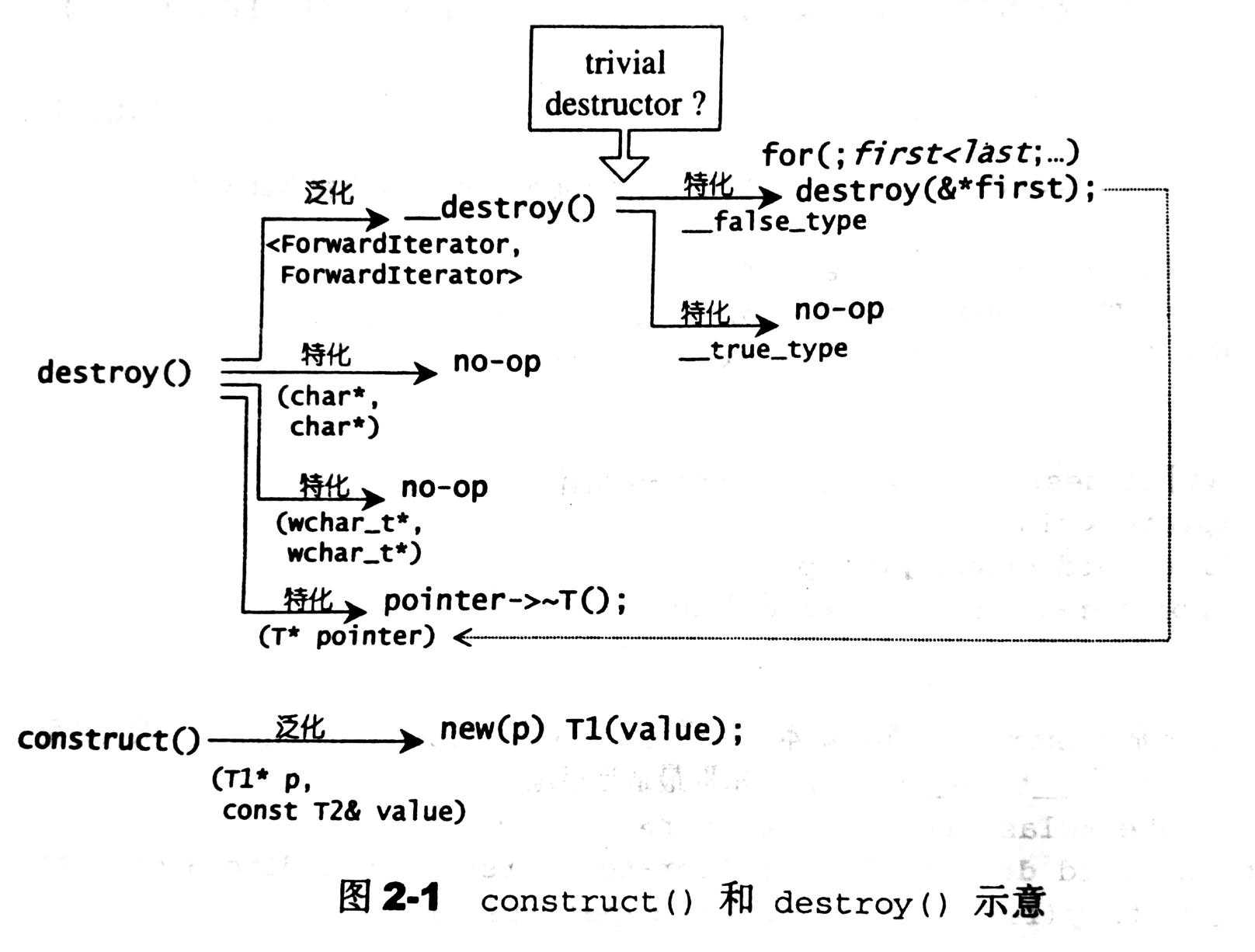STL初探——构造和析构的基本工具: construct()和destroy()
Posted
tags:
篇首语:本文由小常识网(cha138.com)小编为大家整理,主要介绍了STL初探——构造和析构的基本工具: construct()和destroy()相关的知识,希望对你有一定的参考价值。
以下是这两个函数的整体示意图:

construct()和destroy()函数必须被设计为全局函数,STL规定空间配置器必须包含这两个成员函数,但是std::alloc的配置器并没有遵循这一规则。
以下是包含在<stl_construct.h>头文件中的两个函数的的定义:
/* NOTE: This is an internal header file, included by other STL headers. * You should not attempt to use it directly. */ #ifndef __SGI_STL_INTERNAL_CONSTRUCT_H #define __SGI_STL_INTERNAL_CONSTRUCT_H #include <new.h> __STL_BEGIN_NAMESPACE // construct and destroy. These functions are not part of the C++ standard, // and are provided for backward compatibility with the HP STL. We also // provide internal names _Construct and _Destroy that can be used within // the library, so that standard-conforming pieces don‘t have to rely on // non-standard extensions. // Internal names template <class _T1, class _T2> inline void _Construct(_T1* __p, const _T2& __value) { new ((void*) __p) _T1(__value); } template <class _T1> inline void _Construct(_T1* __p) { new ((void*) __p) _T1(); } //第一版本,接受一个指针,好说,直接调用析构函数全部析构 template <class _Tp> inline void _Destroy(_Tp* __pointer) { __pointer->~_Tp(); } //以下是destroy()第二版本,接受两个迭代器,只删除一部分值,该函数设法找出元素的数值型别,进而利用__type_traits<>求取最适当措施 template <class _ForwardIterator> inline void _Destroy(_ForwardIterator __first, _ForwardIterator __last) { __destroy(__first, __last, __VALUE_TYPE(__first)); } //判断元素的数值型别(value_type)是否有trivial destructor template <class _ForwardIterator, class _Tp> inline void __destroy(_ForwardIterator __first, _ForwardIterator __last, _Tp*) { typedef typename __type_traits<_Tp>::has_trivial_destructor _Trivial_destructor; __destroy_aux(__first, __last, _Trivial_destructor()); } //如果元素型别为non-trivial destructor(有意义),逐一删除元素 template <class _ForwardIterator> void __destroy_aux(_ForwardIterator __first, _ForwardIterator __last, __false_type) { for ( ; __first != __last; ++__first) destroy(&*__first); } //如果元素型别为trivial destructor(无伤大雅),什么也不做 template <class _ForwardIterator> inline void __destroy_aux(_ForwardIterator, _ForwardIterator, __true_type) {} inline void _Destroy(char*, char*) {} inline void _Destroy(int*, int*) {} inline void _Destroy(long*, long*) {} inline void _Destroy(float*, float*) {} inline void _Destroy(double*, double*) {} #ifdef __STL_HAS_WCHAR_T inline void _Destroy(wchar_t*, wchar_t*) {} #endif /* __STL_HAS_WCHAR_T */ // -------------------------------------------------- // Old names from the HP STL. //HP STL以前旧的函数命名 template <class _T1, class _T2> inline void construct(_T1* __p, const _T2& __value) { _Construct(__p, __value); } template <class _T1> inline void construct(_T1* __p) { _Construct(__p); } template <class _Tp> inline void destroy(_Tp* __pointer) { _Destroy(__pointer); } template <class _ForwardIterator> inline void destroy(_ForwardIterator __first, _ForwardIterator __last) { _Destroy(__first, __last); } __STL_END_NAMESPACE #endif /* __SGI_STL_INTERNAL_CONSTRUCT_H */ // Local Variables: // mode:C++ // End:
上述 _Construct(_T1* __p, const _T2& __value), 接受一个指针__p和一个初值__value,该函数的用途是将初值设定到指针所指的空间上,通过C++的placement new 运算子来完成。
destory()有两个版本,第一个版本接受一个指针,意思是要释放掉该指针所指的内存,直接调用析构函数就行,第二个版本接受 first 和 last 两个迭代器,意思是析构掉[first, last)范围内的所有对象,这里存在一个型别判断问题,当范围特别大时,而每个对象的析构函数都是trivial destructor(无关痛痒),那么一次次调用这样的析构函数实际上是对效率的一种伤害,因此就应该先利用value_type()判断迭代器所指对象的型别,再利用type_traits<T>判断该型别的析构函数是否真的无关痛痒,是的话(__true_type),则什么也不做就结束,若不是(__false_type),那就通过循环的方式遍历整个范围一一调用destroy()函数进行析构。
以前的C++98并不支持对 “指针所指之物” 的型别判断,也不支持 “对象析构函数是否为trivial” 的判断,现在的C++11新特性有个decltype,可以获取指针所指之物的型别,至于判断__type_traits<>,则需要另外设定对象的特性萃取方案,好在SGI STL里面有一道关于traits编程技法的私房菜,后面再写博客介绍。
以上是关于STL初探——构造和析构的基本工具: construct()和destroy()的主要内容,如果未能解决你的问题,请参考以下文章